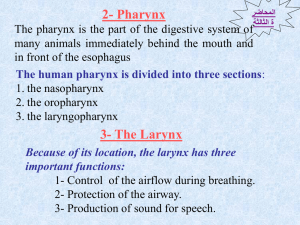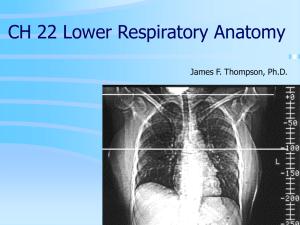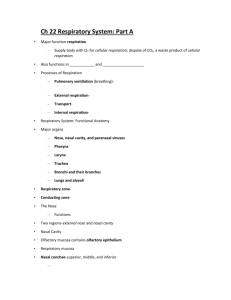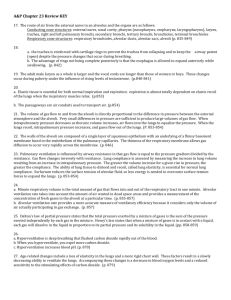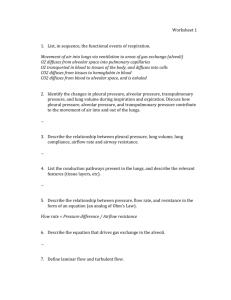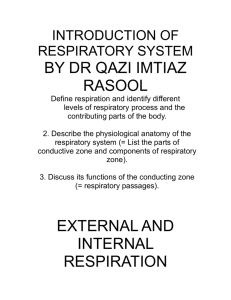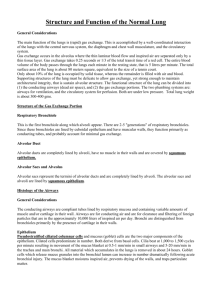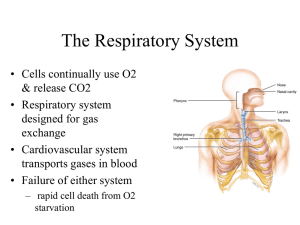The Respiratory System Iii By Dr. Mahjabeen Muneera 11-03-2015
advertisement
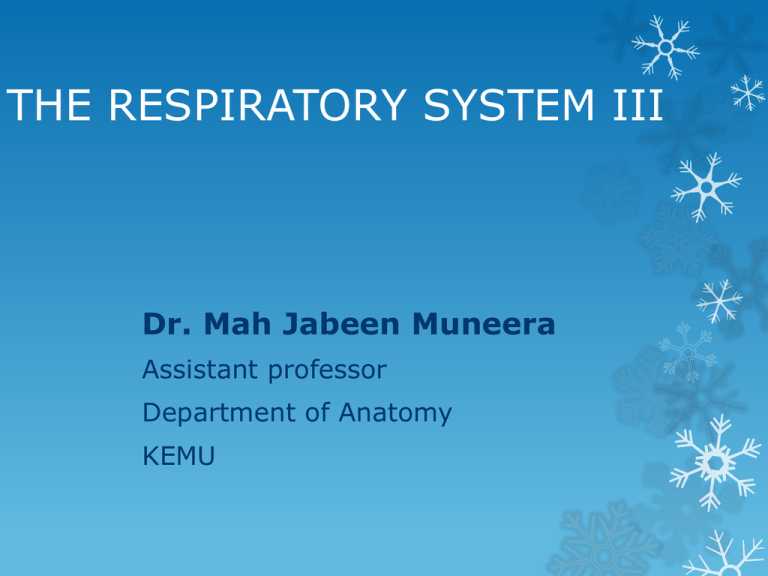
THE RESPIRATORY SYSTEM III Dr. Mah Jabeen Muneera Assistant professor Department of Anatomy KEMU RESPIRATORY BRONCHIOLE Arise from terminal bronchiole Diameter < 0.5mm Transition between conducting & respiratory subdivisions Structurally similar to terminal bronchioles EXCEPT Walls interrupted by out pocketings (alveoli)– gas exchange Epithelium Ciliated cuboidal in larger Simple cuboidal in smaller Lamina propria Smooth muscles Fibroelastic tissue ALVEOLAR DUCT Arise from respiratory bronchioles Completely lined by alveoli Epithelium Simple squamous Smooth Muscles Smooth muscles DISAPPEAR at end of alveolar duct Only elastic & collagen fibers support the wall ALVEOLAR SACS Arise from alveolar duct Epithelium Simple squamous Wall has: Elastic fibers-for expansion Reticular fibers- to prevent over distension Capillaries embedded in this CT ALVEOLI Sac like evaginations open on one side Size 200 µm Between adjacent alveoli is interalveolar septum Elastic & reticular fibers Macrophages, fibroblast, mast cells Continuous capillary bed (from pulmonary artery vein) Air in alveoli separated from capillary blood by respiratory membrane made of Alveolar cells Fused basal lamina of alveolar cell & capillary endothelium Cytoplasm of endothelial cell Jeanne Adiwinata Pawitan Alveoli surrounded by fine elastic fibers Alveoli interconnect via alveolar pores of Kohn– equalize air pressure, collateral ventilation Alveolar macrophages – free floating “dust cells”—Heart Failure Cells Alveolar cells Type I pneumocytes/alveolar cells - squamous alveolar cells) – tight junction – basal lamina – very thin region permeable to gasses Type II pneumocytes/alveolar cells - great alveolar cell – septal cells – surfactant – surface tension decreased prevents collapse Alveolar lining regeneration This “Air-blood barrier” (the respiratory membrane) is where gas exchange occurs Oxygen diffuses from air in alveolus (singular of alveoli) to blood in capillary Carbon dioxide diffuses from the blood in the capillary into the air in the alveolus Alveolar cells Surfactant Type II alveolar cells scattered in alveolar walls Microvilli over free surface Lamellar bodies Phospholipids, surfactant proteins (A, B, C & D) Surfactant is a detergent-like substance which is secreted in fluid coating alveolar surfaces – it decreases surface tension Without it the walls would stick together during expiration Respiratory Distress Syndrome Premature babies – problem breathing is largely because they lack surfactant Role of Steroids Pleura Around each lung is a flattened sac of serous membrane called pleura Parietal pleura Visceral pleura Pleural cavity – slit-like potential space filled with pleural fluid Pleura Mesothelial cells Connective tissue Pleural effusion - fluid Haemothorax - blood Pneumothorax - air Pleuritis - infection Clinical correlation Emphysema Asthma prolonged contraction – expiration Lumen << – wheezing, dyspnea Hypersecretion goblet cell, mucus/serous gl Steroids, Β2-agonist -relax Longterm exposure- cigarette smoke ≈ inh – antitrypsin >< elastase – dust cells – elastic fiber destructed Fibrosis Increased activity of fibroblasts in response to diseases causing distress normal emphysema Clinical correlations Metaplasia Tumors – squamous cell carcinoma you might want to think twice about smoking…. 16
